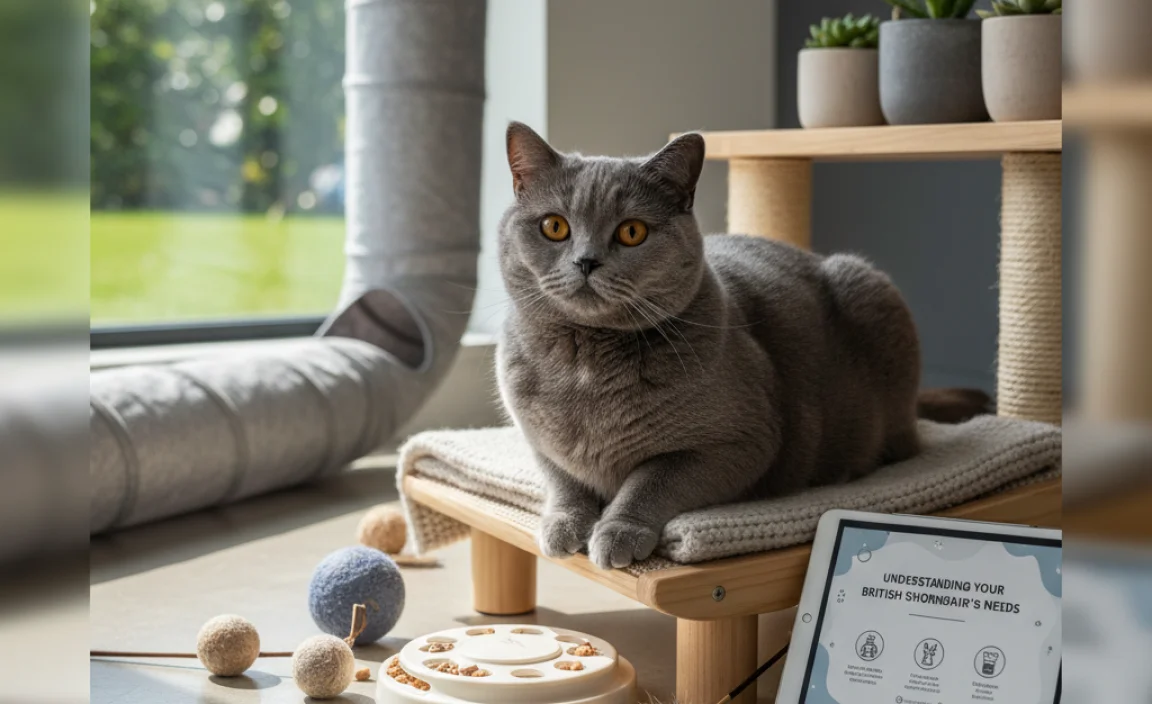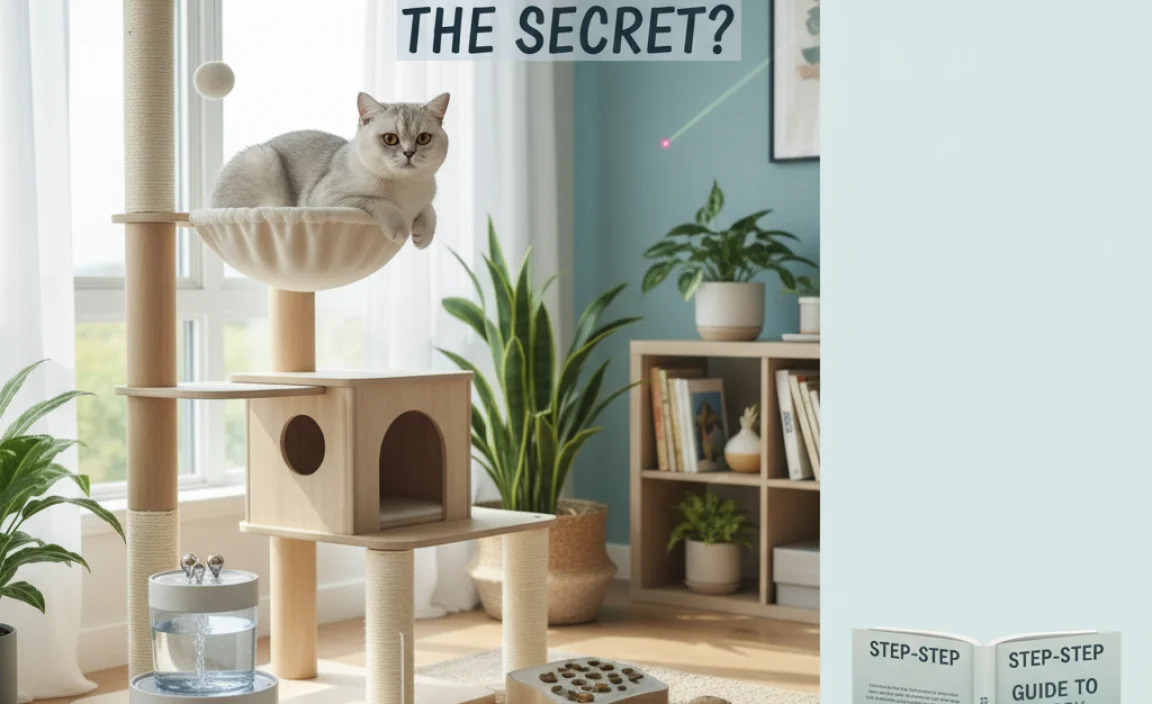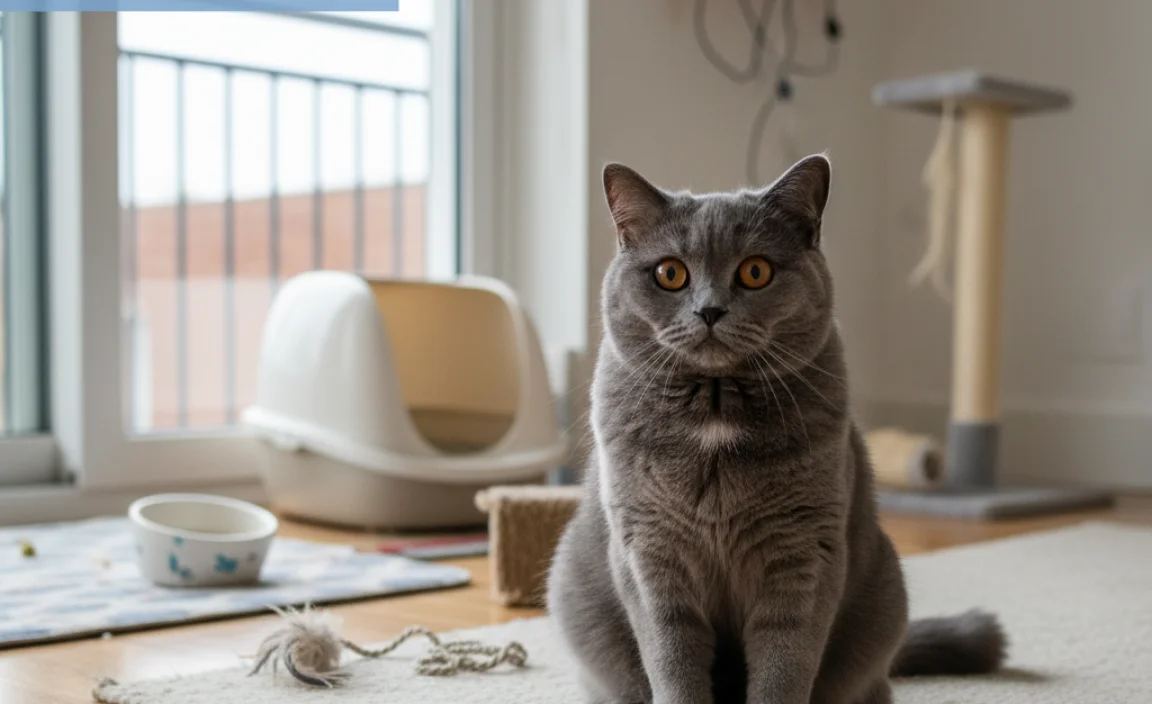Happy British Shorthair Cat Environment: The Secret?
Creating a happy environment for your British Shorthair involves providing them with plenty of love, a safe and comfortable home, enriching activities, and proper care. This includes things like scratching posts, interactive toys, regular playtime, a clean litter box, a healthy diet, and lots of attention!
Bringing a British Shorthair into your home is like welcoming a fluffy, four-legged family member! These cats are known for their calm and affectionate nature, but like any pet, they thrive in an environment that caters to their specific needs. Sometimes, figuring out exactly what makes them tick can feel a bit puzzling. Are they getting enough playtime? Is their environment stimulating enough?
Don’t worry! Creating a happy and fulfilling space for your British Shorthair is easier than you think. I’ll guide you through creating the purr-fect environment for your feline friend, ensuring they live a joyful and healthy life. We’ll cover everything from essential resources to playtime ideas, and even how to understand their unique quirks. Let’s get started!
Understanding Your British Shorthair’s Needs

British Shorthairs are known for their laid-back personalities, but they still have essential needs that must be met to ensure their happiness and well-being. Understanding these needs is the first step in creating a happy environment.
Essential Resources
Just like us, cats need certain essentials to feel safe and secure in their home. Here’s a breakdown:
- Food and Water: Always provide fresh, clean water and high-quality cat food appropriate for their age and activity level.
- Litter Box: Keep the litter box clean and accessible. Most cats prefer unscented litter. The general rule is one litter box per cat, plus one extra.
- Scratching Post: Scratching is a natural behavior for cats. Provide a sturdy scratching post to protect your furniture.
- Bed: A cozy and comfortable bed where your cat can relax and sleep.
- Safe Space: A quiet place where your cat can retreat when they feel stressed or overwhelmed. This could be a cat tree, a cardboard box, or even just a quiet corner of a room.
Creating a Safe Haven
British Shorthairs are generally relaxed cats, but they still need to feel safe and secure in their environment. Here’s how to create a safe haven for your feline friend:
- Eliminate Hazards: Remove any potential hazards from your home, such as toxic plants, cleaning supplies, and loose electrical cords.
- Provide Vertical Space: Cats love to climb and observe their surroundings from a high vantage point. Provide cat trees, shelves, or window perches to satisfy this need.
- Control the Temperature: Keep your home at a comfortable temperature for your cat. Avoid drafts and extreme temperature fluctuations.
- Minimize Stress: Reduce stressors in your cat’s environment, such as loud noises, sudden movements, and unfamiliar people or animals.
Understanding Their Unique Quirks
Every cat is an individual, but British Shorthairs have some common personality traits that can influence their environmental needs:
- Independence: British Shorthairs are known for being independent cats. They enjoy spending time alone, but they also appreciate attention from their owners.
- Playfulness: While not as hyperactive as some breeds, British Shorthairs still enjoy playing. Provide them with plenty of toys and opportunities for enrichment.
- Affection: British Shorthairs are affectionate cats who enjoy cuddling with their owners. Make sure to give them plenty of love and attention.
- Routine: Cats thrive on routine. Try to feed your cat, clean their litter box, and play with them at the same time each day.
Step-by-Step Guide to a Happy Cat Environment

Now that you understand your British Shorthair’s basic needs, let’s dive into the specifics of creating a happy and fulfilling environment for them.
Step 1: Setting Up the Basics
First, let’s make sure you have all the essential resources in place.
- Food and Water Stations: Choose a quiet location away from high-traffic areas. Use shallow bowls to prevent whisker fatigue.
- Litter Box Placement: Place litter boxes in easily accessible locations away from food and water. Consider the number of cats you have and their individual preferences.
- Scratching Post Selection: Offer a variety of scratching posts, including vertical and horizontal options. Place them in areas where your cat likes to scratch.
- Bed Placement: Place your cat’s bed in a warm, quiet location where they feel safe and secure.
- Safe Space Creation: Designate a quiet area where your cat can retreat when they feel stressed or overwhelmed.
Step 2: Enrichment and Playtime
Enrichment and playtime are essential for keeping your British Shorthair happy and stimulated.
- Interactive Toys: Provide a variety of interactive toys, such as puzzle feeders, laser pointers, and wand toys.
- Playtime Schedule: Set aside at least 15-20 minutes each day for playtime. This will help your cat burn energy and bond with you.
- Environmental Enrichment: Create an enriching environment by providing cat trees, shelves, and window perches.
- Rotate Toys: Keep your cat interested by rotating their toys regularly. This will prevent them from getting bored.
- Training: British Shorthairs are intelligent cats who can be trained to do tricks or follow commands. This is a great way to provide mental stimulation.
Step 3: Maintaining a Clean and Healthy Environment
A clean and healthy environment is essential for your cat’s physical and mental well-being.
- Litter Box Cleaning: Scoop the litter box daily and change the litter completely at least once a week.
- Food and Water Bowl Cleaning: Wash food and water bowls daily to prevent bacteria growth.
- Regular Vacuuming: Vacuum regularly to remove cat hair and dander.
- Grooming: Brush your British Shorthair regularly to remove loose hair and prevent mats.
- Veterinary Care: Take your cat to the veterinarian for regular checkups and vaccinations.
Step 4: Understanding Cat Communication
Understanding how cats communicate is key to understanding their needs and creating a happy environment.
- Body Language: Pay attention to your cat’s body language. A relaxed cat will have their ears forward, their tail up, and their body relaxed. A stressed cat will have their ears back, their tail tucked, and their body tense.
- Vocalization: Cats use a variety of vocalizations to communicate, including meows, purrs, hisses, and growls. Learn to recognize what your cat is trying to tell you.
- Scent Marking: Cats use scent marking to communicate with other cats. This includes scratching, rubbing, and spraying.
Here’s a quick guide to understanding your British Shorthair’s vocal cues:
| Vocalization | Possible Meaning |
|---|---|
| Purring | Generally indicates contentment, but can sometimes indicate stress or pain. |
| Meowing | Can mean a variety of things, including “I’m hungry,” “I want attention,” or “I’m stressed.” |
| Hissing | Indicates fear, aggression, or pain. |
| Growling | A warning sign indicating aggression or defensiveness. |
| Chattering | Often heard when a cat is watching birds or other prey. |
Step 5: Addressing Common Behavior Problems
Even in the happiest of environments, behavior problems can sometimes arise. Here are some common issues and how to address them:
- Scratching: If your cat is scratching furniture, provide more scratching posts and make sure they are placed in areas where your cat likes to scratch. You can also use deterrent sprays on furniture.
- Litter Box Issues: If your cat is not using the litter box, make sure it is clean and accessible. You may also need to try a different type of litter. Consult with your veterinarian to rule out any medical causes.
- Aggression: If your cat is aggressive, consult with a veterinarian or a certified cat behaviorist to determine the cause of the aggression and develop a treatment plan.
- Anxiety: If your cat is anxious, try to identify the source of the anxiety and eliminate it. You can also use calming aids such as pheromone diffusers or supplements.
Essential Items Checklist

Here’s a handy checklist of essential items to help you create a happy environment for your British Shorthair:
- High-quality cat food
- Fresh water
- Food and water bowls
- Litter box
- Litter
- Scratching post
- Cat bed
- Cat toys
- Cat carrier
- Grooming supplies (brush, nail clippers)
To help you choose the best food, here’s a comparison table:
| Food Type | Pros | Cons |
|---|---|---|
| Dry Food | Convenient, affordable, good for dental health. | Can be high in carbohydrates, may not be as palatable as wet food. |
| Wet Food | High in moisture, palatable, good for cats with urinary issues. | More expensive than dry food, can spoil quickly. |
| Raw Food | High in protein, natural, may improve digestion. | Requires careful handling to prevent bacterial contamination, can be expensive. |
Expert Tips for a Thriving British Shorthair

Here are a few extra tips from my years of experience with British Shorthairs:
- Regular Play Sessions: British Shorthairs might seem lazy, but they need regular playtime to stay physically and mentally stimulated. Schedule 15-20 minutes of interactive play each day.
- Grooming is Bonding: Regular grooming isn’t just about keeping their coat healthy; it’s also a great way to bond with your cat. Most British Shorthairs enjoy being brushed.
- Monitor Weight: British Shorthairs are prone to weight gain, so monitor their food intake and activity levels. Talk to your vet about the ideal weight for your cat.
- Provide Mental Stimulation: Keep your cat entertained with puzzle toys, treat balls, and window perches. A bored cat is more likely to develop behavioral problems.
- Respect Their Independence: British Shorthairs are independent cats, so respect their need for alone time. Don’t force them to cuddle if they’re not in the mood.
Common Mistakes to Avoid

Even with the best intentions, some common mistakes can negatively impact your British Shorthair’s environment:
- Neglecting the Litter Box: A dirty litter box is a major source of stress for cats. Scoop it daily and change the litter regularly.
- Lack of Vertical Space: Cats love to climb, so provide cat trees, shelves, and window perches.
- Forcing Interaction: British Shorthairs are independent cats, so don’t force them to cuddle or play if they’re not in the mood.
- Punishment: Never punish your cat for unwanted behaviors. This will only create fear and anxiety. Instead, focus on positive reinforcement.
- Ignoring Health Issues: If you notice any changes in your cat’s behavior or appetite, take them to the veterinarian for a checkup.
FAQ: Creating a Happy British Shorthair Cat Environment
Here are some frequently asked questions about creating a happy environment for your British Shorthair:
- Q: How much space does a British Shorthair need?
- A: British Shorthairs are adaptable and can thrive in apartments or houses, as long as they have enough space to move around, play, and explore. Vertical space is especially important.
- Q: What are the best toys for British Shorthairs?
- A: Interactive toys, such as puzzle feeders, laser pointers, and wand toys, are great for keeping British Shorthairs entertained. They also enjoy chasing after toy mice and balls.
- Q: How often should I clean my cat’s litter box?
- A: You should scoop the litter box daily and change the litter completely at least once a week. Some cats may prefer more frequent cleaning.
- Q: How can I tell if my cat is happy?
- A: A happy cat will have relaxed body language, a healthy appetite, and will engage in playful behavior. They may also purr, rub against you, and knead with their paws.
- Q: My British Shorthair is overweight. What should I do?
- A: Talk to your veterinarian about the ideal weight for your cat and develop a weight loss plan. This may involve changing their diet, increasing their activity level, and monitoring their food intake.
- Q: Are British Shorthairs good with children?
- A: Yes, British Shorthairs are generally good with children, as long as they are treated gently and respectfully. Teach children how to properly interact with cats and supervise their interactions.
- Q: How can I stop my cat from scratching furniture?
- A: Provide plenty of scratching posts and place them in areas where your cat likes to scratch. You can also use deterrent sprays on furniture and trim your cat’s nails regularly.
Conclusion
Creating a happy British Shorthair cat environment is all about understanding their needs, providing them with essential resources, and offering plenty of love and attention. By following these steps, you can ensure that your feline friend lives a long, healthy, and fulfilling life. Remember, every cat is an individual, so pay attention to your cat’s unique personality and adjust their environment accordingly. With a little effort, you can create a purr-fect home for your beloved British Shorthair!




